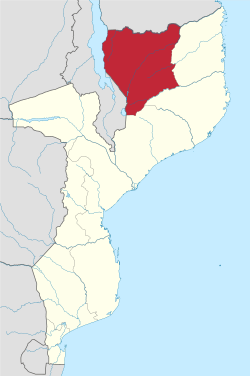Niassa Province
Niassa is a province of Mozambique. It has an area of 129,056 km2 and a population of 1,810,794 (2017).[2] It is the most sparsely populated province in the country.[3] Lichinga is the capital of the province. There are a minimum estimated 450,000 Yao people living in Mozambique. They largely occupy the eastern and northern part of the Niassa province and form about 40% of the population of Lichinga, the capital of this province.
Niassa | |
|---|---|
 Niassa, Province of Mozambique | |
| Country | Mozambique |
| Capital | Lichinga |
| Area | |
| • Total | 129,056 km2 (49,829 sq mi) |
| Highest elevation | 1,836 m (6,024 ft) |
| Population (2017 census) | |
| • Total | 1,810,794 |
| • Density | 14/km2 (36/sq mi) |
| Postal code | 33xx |
| Area code(s) | (+258) 271 |
| HDI (2017) | 0.408[1] low · 8th of 11 |
| Website | www |
The Ruvuma River forms much of the northern boundary of the province with Tanzania while Lake Niassa forms the western border of the province, separating it from Malawi. 75% of the province remains untouched by development, and remains free of landmines.[3] The province shares the Niassa National Reserve with neighboring Cabo Delgado Province.[4]
Districts
Niassa Province is divided into the 15 districts of:
- Cuamba District
- Lago District
- Lichinga District
- Majune District
- Mandimba District
- Marrupa District
- Maúa District
- Mavago District
- Mecanhelas District
- Mecula District
- Metarica District
- Muembe District
- N'gauma District
- Nipepe District
- Sanga District
and the municipalities of:
Demographics
| Year | Pop. | ±% p.a. |
|---|---|---|
| 1980 | 514,100 | — |
| 1997 | 808,572 | +2.70% |
| 2007 | 1,213,398 | +4.14% |
| 2017 | 1,810,794 | +4.08% |
| source:[5] | ||
Education
In 1998, a provincial college was built in Lichinga to train teachers. Partially financed by the Irish Embassy in Maputo, it graduates 60 teachers a year. Apart from training teachers for local schools, the college offers primary school education to the local Lichinga community and works towards reducing the impact of HIV/AIDS in Niassa province.[6]
Villages
There exists a village named Lioma (not be confused with Lioma, Zambezia) in Niassa Province.[7]
References
- "Sub-national HDI - Area Database - Global Data Lab". hdi.globaldatalab.org. Retrieved 2018-09-13.
- "Total Population By Provinces - 2006". Instituto Nacional de Estatística. Archived from the original on November 24, 2007. Retrieved 2008-06-15.
- "Niassa". Archived from the original on 2009-04-08. Retrieved 2009-12-31.
- "The Lions of Niassa". Fauna and Flora International. 2009. Archived from the original on November 3, 2009. Retrieved 2009-12-31.
- Cameroon: Administrative Division population statistics
- "Teacher Training College Niassa". Archived from the original on 2008-04-11. Retrieved 2009-12-31.
-
- Devaka Premawardhana (2018). Faith in Flux: Pentecostalism and Mobility in Rural Mozambique. Philadelphia: University of Pennsylvania Press. p. Figure 1, 59. ISBN 978-0812249989.CS1 maint: ref=harv (link)
External links
External links
- (in Portuguese) Province of Niassa official site
- (in Portuguese) including information about districts